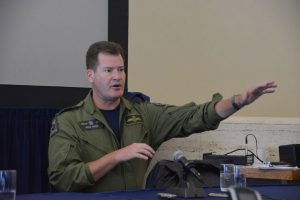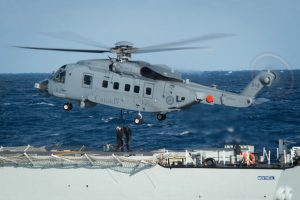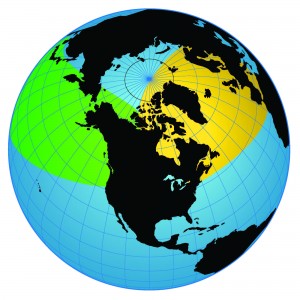2017-07-29 By Robbin Laird
During visits to the UK and Norway earlier this year and to Denmark in the recent past, the concern and commitment to reworking defense capabilities in the North Atlantic was evident. The concern is rooted in the return of Russian power projection efforts and capabilities in the wake of actions in Crimea and elsewhere.
At the Norwegian Airpower Conference earlier this year, the emphasis was on rebuilding capabilities and enhancing core competencies.
Notably, concern was highlighted with regard to Russian actions and capabilities located in the Kola Peninsula or the bastion strategy of the Russians.
The head of the Norwegian Navy highlighted the importance of the new air platforms, and the new submarines and the need to effectively integrate the data provided by those platforms as well as crafting and evolving the C2 necessary to leverage an integrated air-sea force.
The Rear Admiral underscored that flying the same assets as the US Navy, the USAF and the RAF and the Royal Navy would provide enhanced capabilities within the North Atlantic.
The Rear Admiral noted that the Norwegians have never stopped flying their MPAs, in this case their P-3s, over their areas of interest in the North.
They did not send their P-3s to the Middle East, nor did they retire their MPAs as did the UK.
“We have kept this competence not only alive but focused on the key areas of interest to us in the region.”
The P-3s have been “critical to understand the underwater domain for our forces. We are buying the P-8 because of its capability and the priority to focus upon this capability.
https://sldinfo.com/the-norwegian-navy-and-shaping-air-sea-integration-for-norwegian-defense/
The British had let their ASW assets be retired but are now preparing to fly the P-8s from RAF Lossiemouth but in the interim period kept their skill sets alive while flying RAF ASW personnel onboard other allied ASW platforms.
The Joint Warrior exercises were especially important in this regard.
According to one senior RAF officer involved in the ASW effort: “We have continuously sent officers to work with our allies abroad to keep their skills current as well.
“We are well replaced to the new challenges.
“The training we have given our ex-MPA guys in flying and operations with our allies is crucial.
“This will allow us to slot in people very quickly as the P-8 becomes operational.”
“But it is a clear challenge.”
One of those core allies who have provided a key asset to fly on to keep those ASW skill sets alive has been the Royal Canadian Air Force.
Recently, I had a chance to talk with Lt. General Michael Hood, head of the RCAF about the Canadian ASW efforts and their approach to the way ahead as core allies rework their assets and their approach to dealing with the ASW challenges in the North Atlantic and the High North.
 Lt. General Michael Hood assumed command of the Royal Canadian Air Force in 2015.
Lt. General Michael Hood assumed command of the Royal Canadian Air Force in 2015.
With regard to the RAF, this is what Lt. General Hood highlighted: “We have been flying two members of the RAF crews on our ASW aircraft in the interim between the sunset of Nimrod and the sunrise of the P-8.
“We have also filled the gap left by the sun setting of Nimrod with our own ASW assets. We have done so by operating from either RAF Lossiemouth or Keflavik to help manage the GIUK gap.
“Out of all of the NATO ASW platforms in there, the most effective one has been our CP-140.
“I am exceptionally proud of our ASW capability and when I couple it with the new advanced capability on our upgraded frigates, I see us a backbone of NATO’s ASW capability.”
The current ASW capabilities of Canada are built around an upgraded CP-140 with the acquisition of a new CH-148 Cyclone ASW helicopter and the modernization of the Canadian frigates integrated into the ASW coalition operations.
Over the decade ahead as the maritime domain awareness and strike enterprise is reworked with the coming of the P-8 and the Triton (among other assets) Canada will add an unmanned capability, continue upgrading the CP-140 and work closely with the allies in reshaping the maritime domain awareness and strike networks.
And added to that as well will be new satellite sensor and communications systems as well.
 CP-140 Aurora. Credit: RCAF
CP-140 Aurora. Credit: RCAF
This will allow the RCAF to leverage developments in the next decade to determine what needs to be put on their replacement manned air platform and to determine which air platform that would be.
Lt. General Hood provided an overview of how he saw the current Canadian capabilities and the way ahead.
“The government’s new defense policy lays out a twenty-year funding line that recapitalizes our air force.
“The eventual replacement of the CP-140 is funded in that defense policy but this is not a near term need.
“We have better capability from an ASW perspective in the CP-140 than comes off the line presently in the P-8.
“We have just gone through a Block III upgrade that has completely modernized the ASW capability as well as adding an overland ISR piece.
“We have replaced the wings on many major empennage points and the goal is to get our CP-140 out to about 2032 when we’re going to replace it with another platform.”
He noted that next year, the CP-140s will receive a Block IV upgrade which will include new infrared counter measures, a tactical data link 16 to complement link 11 and full motion video, imagery, email, chat, and VOIP.
The General noted that the new defense policy has authorized adding a UAs capability for the ASW effort as well.
“In the next three years, we’ll be under contract for a medium altitude UAS system that is going to have both domestic and coastal abilities as well as expeditionary strike capabilities.
“We participate in NATO AGS as well.
“We’ve got a number of people and have funded significantly NATO AGS in a Triton-like capability.”
And now that the RCAF has been given the space mission, the General discussed as well the satellite side of the equation with regard to ASW and the High North as well.
The new RADARSAT constellation will provide enhanced sensor coverage and Canada plans to launch a polar constellation satellite system to provide for High North communication needs.
“That is actually going to finally allow us to see operate UASs up above 70 degrees north.”
We discussed throughout the interview the evolving maritime domain awareness network and the reshaping of its capabilities as new sensors, platforms and C2 systems come on line.
“What will the network be able to deliver?
“As we add new UAS capabilities with manned capabilities how do we reshape what is on each platform?”
 Canada’s CH-148 Cyclone maritime helicopters are now well into test and evaluation. Crews are reportedly impressed with their anti-submarine and above-water warfare suites. MCpl Jennifer Kusche Photo
Canada’s CH-148 Cyclone maritime helicopters are now well into test and evaluation. Crews are reportedly impressed with their anti-submarine and above-water warfare suites. MCpl Jennifer Kusche Photo
And it is from this context that the head of the RCAF sees the question of a replacement aircraft for the CP-140.
“What do we need to put onto the new manned platform from the standpoint of the evolution of the network.
“Canadian industry has played a key role in shaping capabilities onboard the CP-140 and I would see that role continuing on our replacement manned aircraft.
“It’s less about the platform, but the brains of that platform.”
And we extended that discussion to more general set of challenges facing NORAD as well.
Lt. General Hood highlighted the importance of the working relationship within NORAD and relevant US commands as part of the overall effort to reshape the systems which can deliver defense to North America.
“I’ve just had staff talks with General Dave Goldfein and General Jay Raymond from US Space Command and I can tell you that certainly on the space side, we are the critical partner of your country in sharing that burden in space and making sure that we’re ready for the future.”
When we interviewed the former head of Northcom/Norad Admiral Gortney he highlighted the growing threats to the 10 and 2 O’Clock as he put it.
But the challenge for us is to shape what we in the US Navy call the NIFC-CA or Naval Integrated Fire Control—Counter Air battle network solution for North American defense.
Put in simple terms, we need to shape a more integrated air and maritime force that can operate to defend the maritime and air approaches to North America as well as North America itself.
We can look at the evolving threat as a ten o’clock and a two o’clock fight, because they originate from the ten and two.
And the ten o’clock fight is primarily right now an aviation fight.
They’re moving capability there, but it’s nothing like what they have at the two o’clock fight.
The two o’clock fight is more of a maritime fight.
 This is a notional rendering of the 10 and 2 O’Clock challenge. It is credited to Second Line of Defense and not in any way an official rendering by any agency of the US government. It is meant for illustration purposes only.
This is a notional rendering of the 10 and 2 O’Clock challenge. It is credited to Second Line of Defense and not in any way an official rendering by any agency of the US government. It is meant for illustration purposes only.
And Admiral Gortney highlighted the importance of Canada in this effort.
For 58 years, we have had a bi-national command, NORAD.
“The current government faces a set of tough problems, not the least of which due to past governments not addressing re-capitalization.
Clearly, what they need to do is to recapitalize their air and maritime force, and preferably one that can work together from the ground up as an integrated force.
I think NORAD needs to become a multi-domain command, and their forces could flow into that command and out of that command as a key enabler.
Editor’s Note: The photos and video are credited to the Royal Canadian Air Force.

